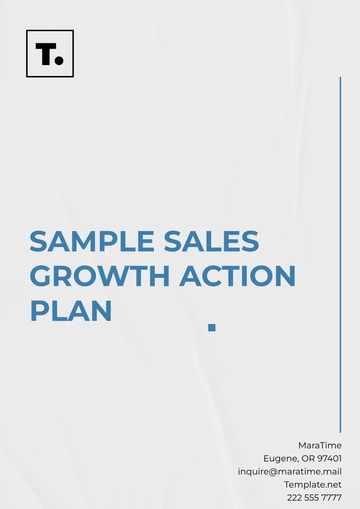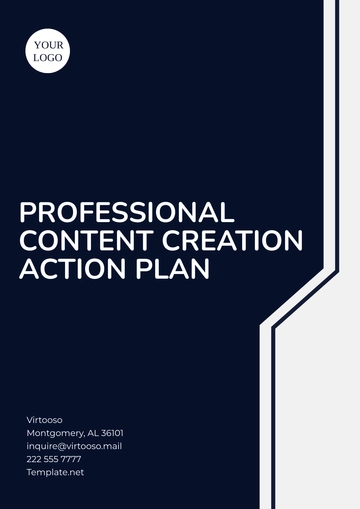Free Content Marketing Brand Action Plan

Prepared by: [Your Name]
Company: [Your Company Name]
Date: [Date]
1. Executive Summary
This Content Marketing Brand Action Plan outlines a comprehensive strategy designed to elevate brand visibility, foster deeper audience engagement, and drive lead generation through high-quality content creation, distribution, and optimization. The plan emphasizes a data-driven approach to connect with diverse customer segments, focusing on brand awareness, engagement, and loyalty. By creating compelling content aligned with audience needs, this plan aims to strengthen brand positioning in the market and increase measurable ROI.
2. Target Audience Analysis
2.1 Audience Segmentation
We will categorize our target audience into three primary segments based on demographics, psychographics, and buying behavior:
Segment 1: Millennial Entrepreneurs
Demographics: Ages 25-40, primarily located in urban areas, tech-savvy, small business owners.
Psychographics: Ambitious, value innovation, driven by efficiency.
Buying Behavior: Frequently online shoppers, prefer brands with a strong social media presence and a digital-first approach.
Segment 2: Corporate Decision-Makers (B2B)
Demographics: Ages 35-55, typically executives and senior managers, working in mid to large corporations.
Psychographics: Risk-averse, focus on ROI, value stability and long-term partnerships.
Buying Behavior: Decision-making driven by performance metrics, prefers in-depth case studies, whitepapers, and detailed product demos.
Segment 3: Gen Z Consumers
Demographics: Ages 18-24, highly active on social media, college students or early professionals.
Psychographics: Value authenticity, social consciousness, and digital entertainment.
Buying Behavior: Highly influenced by peer recommendations, influencer partnerships, and video content (YouTube, TikTok).
2.2 Audience Needs and Preferences
Based on audience data and survey insights, we have identified the following content preferences:
Millennial Entrepreneurs: Seek content around business productivity tools, growth hacks, and time management.
Corporate Decision-Makers (B2B): Prefer long-form content such as whitepapers, case studies, and webinars that focus on ROI and business efficiency.
Gen Z Consumers: Engage with short-form video content, tutorials, influencer endorsements, and lifestyle-oriented blog posts.
3. Content Goals and Objectives
Enhance Brand Awareness: Develop content that educates and informs audiences, positioning the brand as an industry leader.
Improve Audience Engagement: Foster meaningful interactions through comments, shares, and direct engagement via social media platforms.
Generate Quality Leads: Leverage gated content like eBooks, webinars, and industry reports to drive conversions.
Build Brand Loyalty: Create customer-centric content that resonates with the audience and aligns with their values, encouraging repeat visits and referrals.
4. Content Strategy Development
4.1 Content Types
To best serve the needs of our audience, we will employ a mix of content formats:
Blog Posts: Focused on industry trends, how-to guides, and thought leadership.
Videos: Short-form social media videos, YouTube tutorials, behind-the-scenes content.
Infographics: Visual content showcasing data, research findings, and process flows.
Podcasts: Expert interviews and discussions around market trends, innovation, and entrepreneurship.
4.2 Content Themes and Topics
The central themes and topics for the upcoming quarter include:
Millennial Entrepreneurs:
“10 Productivity Hacks for Small Business Owners”
“How to Scale Your Startup Without Burning Out”
Corporate Decision-Makers:
“Maximizing ROI with Data-Driven Decision Making”
“Building a Culture of Innovation in the Workplace”
Gen Z Consumers:
“The Future of Sustainability: How Brands Are Making a Difference”
“Top 5 Social Media Trends You Can’t Miss in 2050”
5. Content Creation Process
5.1 Content Planning
Content Calendar: We will plan content releases on a weekly basis, ensuring a balanced mix across blog posts, videos, and social media. Example schedule:
Week 1: Blog post on “How to Scale Your Startup”
Week 2: YouTube video tutorial on business tools
Week 3: Infographic on “Maximizing ROI”
Week 4: Podcast with industry experts
5.2 Content Production
The content team will consist of:
Writers: Skilled in creating SEO-optimized articles and long-form content.
Designers: Responsible for infographics, video graphics, and website visuals.
Editors: Ensuring content meets brand guidelines and quality standards.
Video Production Team: Creating engaging video content for social media and YouTube.
6. Content Distribution
6.1 Distribution Channels
We will distribute content through the following key channels:
Social Media: Facebook, Instagram, LinkedIn, and TikTok to engage with different audience segments.
Email Marketing: Monthly newsletters, content offers, and promotional campaigns.
Website: Content hub with a focus on lead generation, resources (eBooks, whitepapers), and blog posts.
YouTube: For hosting educational and behind-the-scenes videos.
6.2 SEO and Optimization
On-Page SEO: Utilize keyword research to target long-tail keywords and optimize blog posts and landing pages.
Off-Page SEO: Implement backlinking strategies through guest posts and influencer collaborations.
Content Optimization: Regularly update older content for SEO relevance and freshness.
7. Content Performance and Metrics
7.1 Key Performance Indicators (KPIs)
The success of our content strategy will be measured using the following KPIs:
Engagement Rate: Likes, shares, comments, and overall interaction with content.
Conversion Rate: Percentage of visitors who take a desired action, such as signing up for a newsletter or downloading a resource.
Website Traffic: Number of visitors to the site from organic search and referral links.
Lead Generation: Number of leads captured through gated content.
7.2 Performance Analysis
We will use tools like Google Analytics, HubSpot, and social media insights to track and measure performance. Regular performance reviews will help refine the strategy and optimize content types, distribution channels, and audience targeting.
8. Conclusion
This Content Marketing Brand Action Plan provides a structured approach to enhancing brand visibility, driving engagement, and generating leads. By consistently creating high-quality content that resonates with our diverse audience segments, we aim to position the brand as a thought leader in the industry, foster long-term customer relationships, and deliver measurable business results.
- 100% Customizable, free editor
- Access 1 Million+ Templates, photo’s & graphics
- Download or share as a template
- Click and replace photos, graphics, text, backgrounds
- Resize, crop, AI write & more
- Access advanced editor
Elevate your marketing strategy with the Content Marketing Brand Action Plan Template from Template.net. This fully customizable and editable template ensures effortless planning and branding success. Easily editable in our AI Editor Tool, it’s designed for flexibility and precision, helping you create impactful action plans that resonate with your audience. Streamline your content marketing today!





























